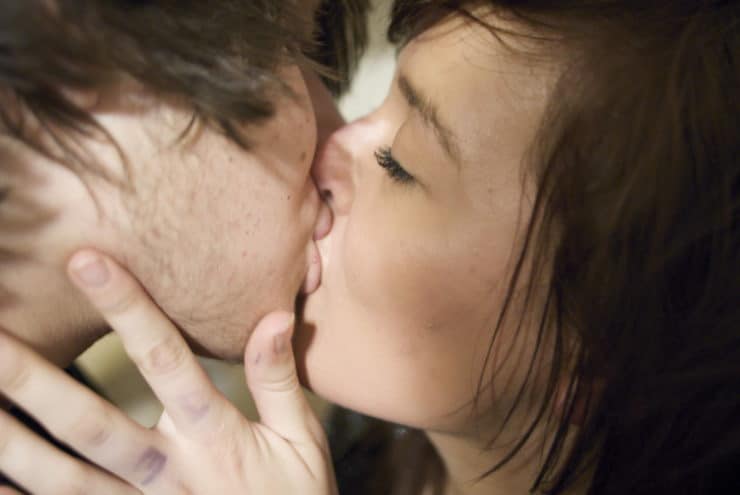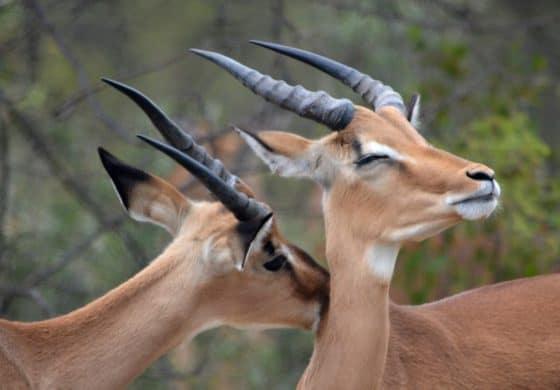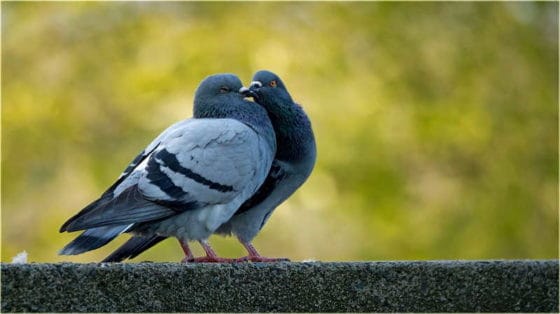Kissing supposedly shows the highest form of affection, so it may seem blasphemy trying to explain it by chemistry, natural selection, or even mathematics.

But let’s give it a try and answer a few intriguing questions: Are humans the only animals that kiss? How did kissing evolve, and what function does touching of lips serve?
Do animals kiss? Oh yes, they do!
Kissing appears to be a bizarre thing for a living being to do, right? Touching with lips, sensing and tasting each other, and closing eyes during the process. Surely only humans do it, right? Well, not exactly.
Kissing is much present in the animal kingdom. To acknowledge this, however, you need to accept that kissing comes in different forms.
Our closest relatives do it in a very similar way to us. That is, chimps and bonobos kiss mouth to mouth, with the latter even going full French sometimes.
But kissing isn’t necessarily touching of lips or tongues. Humans of different cultures also touch or rub lips to cheeks, cheeks to cheeks, nose to nose, or even nose to hair. So why not acknowledgeckissing-like things that animals do.

For example, cats sniff each other’s faces and rub cheeks. Dogs lick not only each other’s faces but also those of their human companions.

Face-to-face communications that include touching, sniffing, and tasting are common among many animals.
Smaller rodents are very much into it. Grazing ungulates groom each other, and elephants often examine each other’s trunks. Birds pluck their partner’s feathers and touch their beaks together.

Thus, there are quite a few examples of kissing or kissing-like behaviors in animals. And we are sure to find more. Heck, even some flies do things that resemble kissing during their pre-mating rituals.
How did kissing evolve?
The prevalence of kissing in the animal kingdom leads us to ask for the evolutionary explanation of kissing. Firstly, did kissing evolve? If it did, from what behaviors did it emerge, and what reproduction and survival benefits does it provide us?
Let’s look at the most commonly suggested explanations for the origins of kissing:
- Kissing evolved from face-to-face interactions. Such interactions are common, especially among mammals. Facial investigations allow insights about the other party, with odors playing an important part. And where there is scent, there is also taste. Thus, if we are close enough to sniff the lips of a potential partner, why not also taste them. If they allow, that is.
- Kissing evolved from mouth-to-mouth feeding. Books about raising a human baby suggest using a fork to smush a pea before feeding. But forks were not present in nature before humans invented them, so how would earlier mothers have dealt with it? They would pre-chew the food, just like many apes nowadays do, and feed it mouth-to-mouth. To link it with kissing, though, requires a leap of faith, in my humble opinion. The theory goes that the behavior expanded to partner feeding, subsequently turning into a sign of provisioning, commitment, love, and eventually kisses.
- Kissing evolved from our attraction to lips. An alternative, but maybe a supplementary theory, suggests that kissing is a product of so-called genital echo. Genitals of female mammals are indicators of their reproductive cycle phase. From dogs to chimps, vaginal lips become large during the receptive period giving some clues. Ever since humans started to cover their private parts, these signals were hidden. But, to avoid being lost, they echoed to lips, which is why large lips are sexually attractive.
The two latter theories, in my opinion, require several assumptions, and the fact that kissing arose from face-to-face interaction, I find the most satisfying. But it may be a matter of opinion.
If you’d like to explore more, I suggest a book by Sheril Kirshenbaum: “The Science of Kissing: What Our Lips Are Telling Us.” Meanwhile, we should move on to the benefits that a kiss provides to us as a species.
What are the functions of a kiss?
Kissing, the lip-touching part, involves some serious risks. We now know that the best way to stop virus spread is by social distancing and avoiding handshakes. Kissing, god forbid, seems a very unreasonable thing to do.

But we still do it! Quite often, we kiss on the first date with someone we barely know. It suggests that there must be benefits from kissing beyond the risks, especially because kissing feels good.
And nature tells us that, if something feels good, it must be (or must have been) evolutionary beneficial. What could these benefits be?
- Partner assessment. Mounting evidence suggests that kissing helps us indicate whether the potential partner is any good. Kissing involves tasting the partner and sensing odor, which, though partially lost, is still informative for humans. Several studies have found that people assess potential partners by their kissing abilities. Women especially find kissing ability an important quality of potential partners, which makes sense. Women are, unfortunately, in need of more careful partner assessment than men are since having kids with a “wrong” partner bears uneven consequences for the sexes.
- Mutual bonding. Kissing per se involves letting someone really, really close. This is an act that requires great trust. Thus, kissing is sort of proof that faith is present in the relationship. Indeed, partners who kiss more are also more satisfied with their relationship. Note, though, it’s not that kissing can improve relationships, but rather that frequent kissing is sort of an indicator of a relationship going well.
- Sexual arousal. Kissing is a part of foreplay too often, so it supposedly serves a function of sexual arousal. Though, as logical it sounds, science has found little support for it. It might as well be that we learn to associate kissing with sexual arousal because we know that sex often follows kissing, and we learn to anticipate it.
As you can see, different functions of a kiss can be at play, depending on circumstances. For example, a kiss as a sign of bonding and trust is vital for long-term partners. However, kissing as a quality check is valuable for casual or new relationships.
Regardless, the above shows that kissing is far more complicated than a first glance may reveal. And I haven’t even talked about non-sexual kisses, as between friends, parents and children, or between Russian political party leaders; this would only complicate matters.
Definitely, we are not the only animals who kiss. This fact suggests that kissing may have arisen through evolution, and is likely to serve a few purposes in our struggle for existence, partner finding, and reproduction.
![]() Do you want to learn more about what science has discovered about kissing?
Do you want to learn more about what science has discovered about kissing?
Read: “The Science Of Kissing: What Our Lips Are Telling Us” by Sheril Kirshenbaum
Disclaimer: I earn a commission if you buy through my link.